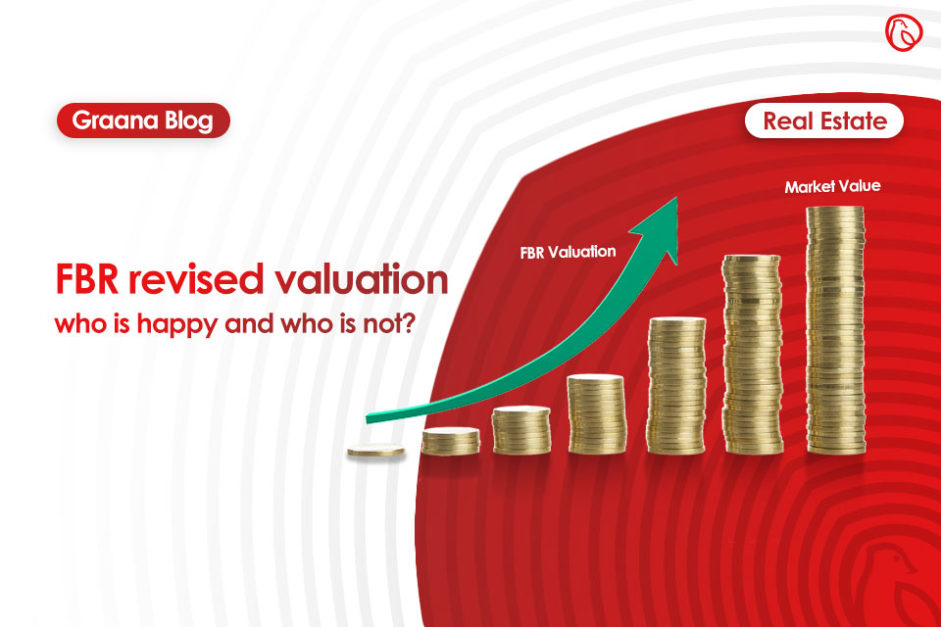The Federal Board of Revenue (FBR) has announced revised valuation tables for the immovable properties of 21 cities. It’s the second time in the last six months that FBR’s property prices have been jacked up in order to bring these closer to the fair market value.
Now, since the values have come closer to almost 80% of the fair market values, it is very important to document the changes that are to follow this development.
Graana.com will delve into details regarding how the revised valuation will affect real estate agents, investors, buyers and sellers, the government, and overall the real estate sector. It will attempt to find a holistic answer to whether such appraisals in real estate prices are favourable for the industry or not.
However, before we consider discussing each stakeholder in detail, let’s have a brief account of what used to happen when there were no FBR valuation tables in Pakistan.
Real Estate Market Before FBR Valuation
FBR valuation tables were introduced to the real estate market in 2016. Before that, there were – and still are – District Collector (DC) rates for immovable properties. These rates are determined and updated by provincial governments on the district level and are managed by the districts’ excise and taxation offices. The DC rates were announced in the 1980s in Pakistan.
So who or what actually controlled the real estate market before the 1980s? The same offices!
Even before DC rates, these offices were entitled to approve or disapprove property prices at the time of transaction. Although, property transactions did not much consider consulting taxation offices for fair market value. However, if anyone did want to do that, they would have to appear before these officers to get their transaction value approved.
Now a question arises – if a system was already running then, why bring state-specified property valuation (DC rates) for the immovable properties?
Among different reasons, the major one was to make the sector more efficient, so that maximum revenue could be yielded. Secondly, it dictated a certain cap for the prices of immovable properties of different provinces so that transactions could be made either at DC rate value or above it; and price fall, in whatsoever case, is controlled.
Till the start of the 1990s, the gap between the actual market value and DC rates was quite low. It was after 1992-93 that a surge in property prices was witnessed across the country and the gap between the two values widened; which continued till 2016.
When the federal and provincial governments felt that the sector has become a preferred investment destination both for resident and overseas Pakistanis, they started imposing taxes.
In 2016, FBR decided to intervene on behalf of the federal government and introduce valuation tables for immovable properties, so that undervaluation of the property transactions is discouraged and revenue generation (under income tax) is increased.
The situation was further aggravated as now investors had to consider three different rates for a single unit of property – DC rates, FBR rates, and actual market value. The market saw a temporary freeze in the activity, as no one was ready to declare actual price and consequently, pay higher taxes.
However, the bubble did not remain for long because, one, there was still a huge gap between the actual market price and FBR valuation, and two, this gap was rapidly increasing. Therefore, investors had no issue to document the property transaction value on the sale deed as per the FBR valuation; as the documented value of the property still was hardly 20-30% of the actual market value.
The situation remained unclear until the previous government revised valuation tables in 2018. The incumbent government again revised it in February 2019, and vowed that the FBR valuation will be brought closer to 85% of the actual market value of the immovable properties.
Hence, as expected, the new tables have been notified, which show a remarkable increase in the valuation if compared with FBR’s February revision.
Increase in FBR Revised Valuation
The revised valuation tables have shown an increase of 15-250% for the different properties of the major cities. Some argue that in some regions of Karachi, the FBR rates have even surpassed the actual market value of the property.
In Karachi, the valuation for residential plots has increased by 25-42%, while for built property it stands at around 15-100%. Similarly, rates for commercial properties too have surged by 25-47% and 11-19% for plots and built properties, respectively. FBR valuation for flats has been amplified by 10-66%.
In Rawalpindi, FBR prices for residential properties have increased by 25-42%, and for commercial units, it is around 15-38%.
FBR valuation for residential properties for sale in Islamabad increased by 30-269% and 40-55% for commercial properties for sale in Islamabad. For flats, there has been an increase of 50-75%.
In Lahore, though residential properties witnessed a surge of 15-50% in FBR valuation, it did not much increase for commercial units and stayed at 17-21%.
It is, however, to be kept in mind that to identify the increase, areas where real estate activity is relatively higher have been considered for the analysis. Likewise, there are some areas where FBR valuation has decreased if compared with the previous valuation tables. However, such areas are extremely few, therefore do not merit in-depth analysis.
Having known the current increase in the FBR valuation and that it has reached to almost 80-85% of the actual market value, we’re probably in a better position to identify what it unfolds for different stakeholders of the real estate sector.

How does FBR revised valuation benefit the government?
The government is undoubtedly the major beneficiary of the revised FBR valuation.
Consequent to the increase, revenue collection from the sector will increase in two ways: one, since tax is collected on the documented value, with FBR now jacking up its prices, the documented price increases and so does the applicable tax; second, could evade showing money trail if he/she buys any property and pays 3% on the differential amount between FBR valuation and actual market value.
Since the 3% amnesty has been abolished in the budget, a buyer now has to show white money/money trail to purchase any property. Consequently, more capital would come into the tax net through real estate transactions.
At the same time, since the property was being purchased for a relatively less amount (as per FBR valuation) and will now be sold on revised rates, applicable capital gains tax (CGT) increases. It is estimated that the revised valuation could bring the government around Rs40 billion in revenue, which is more than what the sector actually pays to the national exchequer in total.
Similarly, by closing the gap between actual market value and FBR’s values, the parking of ill-gotten money in this sector could be uprooted in an efficient way. International Monetary Fund (IMF) has commented in its report that such measures are vital to document the national economy.
Impact of revised FBR valuation on investors
As discussed, the revised rates will shut the door to tax evasion. For a long, the real estate sector has been a safe haven for investors who traded real estate as a commodity. With the closing gap between the two prices, there is a less attraction for those who would buy property on cheaper prices, evade taxes and sell out at exorbitant prices. Money would be laundered and huge sums of profits would be bagged.
Moreover, the IMF has asked the PTI-led government to declare a long-term lease hold of a property as a business strategy and be taxed as business income. The government actually did it in the Budget 2019-20, but backtracked upon stern response from the industry. However, since most of the investors have resorted to investing in built properties, they probably should be happy with any measure that is aimed at regulating the sector.
Critics of the existing real estate system of Pakistan believe that due to trading real estate as a commodity, the market in Pakistan grew vertically since 1990s, which pushed the property prices beyond the reach of a common man. Revised FBR valuation may bring the prices down to a certain level, as potentially, the market may lose ambitious investors.
On the other hand, as discussed, the current system provides enormous opportunities to investors who could invest in the real estate development sector, primarily housing sector.
Investors also expect that to avoid probable plunge in the real estate prices – after revised valuation – the government should consider giving a one-time amnesty to investors for the regularisation of the properties on their actual market value.
Impact of FBR revised valuation on real estate agents
For real estate agents, the situation seems to be similar to what actually happened just after 2016 when FBR intervened in the system by bringing valuation tables. The market slumped but levelled afterwards. Being deal brokers, estate agents are the first to get affected by decreasing activity in the sector, especially if investors pull out their interest.
However, on the other side, if property sale and purchase start at actual and realistic market value, there is a good possibility that the number of potential buyers and sellers could increase.
Interestingly, the revised valuation did not shock all estate agents. A few of them also believe that the market has gone unrealistic, as property sale and purchase have accumulated into hands of a few investors. Such measures could help align the realty sector with global practices, which benefits all stakeholders; particularly property agents, who are always beneficiaries of a smooth and customer-friendly system.
Impact on general buyers and sellers
Presumably, since real estate transaction activity may decrease, it is likely to hurt sellers. However, as discussed, it may not take much time. The major problems they could face include finding filer buyers, paying increased taxes and for longer withholding periods, and most importantly, closing a deal against attractive offers.
However, as previous trends depict that though market activity gets affected with such measures, property prices never fall much. Therefore, sellers don’t need to worry about it, as the market once again is in lower ebbs.
For buyers, the situation seems to be quite encouraging. In fact, they are the real beneficiaries of FBR’s upward valuation. For example, as tax on differential amount (between FBR and actual market) has been abolished, the payable tax for buyers has reduced. Similarly, if provinces agree to FBR’s recommendation and club stamp duty (3%) and capital value tax (2%) into just one percent (though not anytime soon), the situation seems to be going quite in their favour.
Secondly, with temporary recession in the market, they have lots of options available on quite competitive prices. Moreover, analysts also believe that they might benefit from price devaluation.
How will the real estate sector react to such measures?
The revised FBR valuation table is a key step towards regularising the real estate sector. A temporary bubble may be seen in the market, but it will settle down eventually. If the market starts working on one and realistic valuation, it will increase revenue generation, attract foreign direct investment and help in improving cost of doing business in Pakistan.
For example, real estate is the first commodity every business needs to acquire. If it is traded on stable and reasonable prices, the overall cost to business decreases. Similarly, the more the sector is regularised, the more there are chances for foreign investors to consider investment; particularly, in the housing segment.
Likewise, a stable and profitable industry can invest in the stock market as well. Although Dolmen Mall Karachi initiated real estate investment trust (REIT) to encourage shareholding in real estate projects, the unfavourable system could not support it. However, it is hoped that with FBR’s revised valuation, a practical step has been taken in a positive direction.




